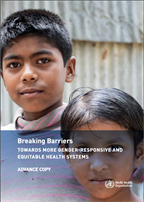Breaking barriers towards more equitable health systems for everyone
Every day, millions of people, often from the most marginalized populations in society, struggle to access health services and achieve positive health outcomes. A critical challenge to making progress towards universal health coverage (UHC) comes from persistent barriers to accessing health services, as noted in WHO’s 13th General Programme of Work. Reaching the General Programme of Work’s 3 billion targets will require systematic incorporation of analysis of barriers into health planning, so that coverage can be expanded with a focus on reaching the disadvantaged populations that are most in need. The GPW states that the WHO Secretariat will work with countries to identify barriers to access health services and provide evidence-based solutions to support progressive expansion in access […].
WHO is operationalizing its efforts towards Health for All by ensuring the health of everyone, especially those in the most disadvantaged or vulnerable situations. In keeping with this, the WHO GER global network is advancing methods to identify supply-side bottlenecks and demand-side barriers using the Tanahashi framework for effective coverage, gender analysis, and human rights-based approaches. This work is fundamental to achieving UHC as well as the health-related targets of the Sustainable Development Goals, and breaking the intergenerational transmission of health inequities.













